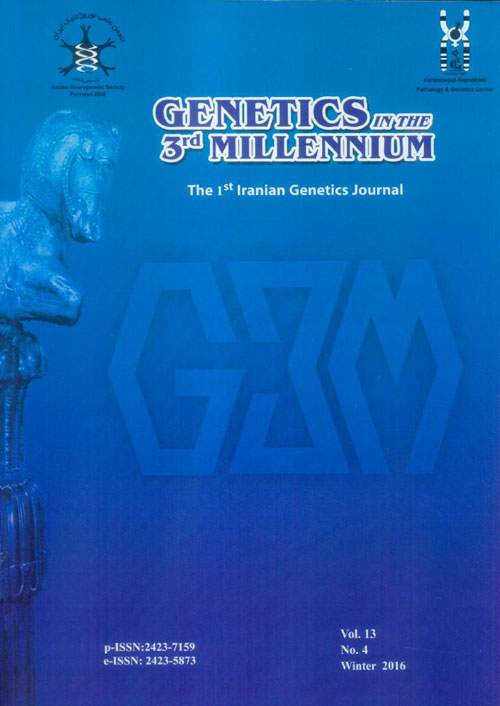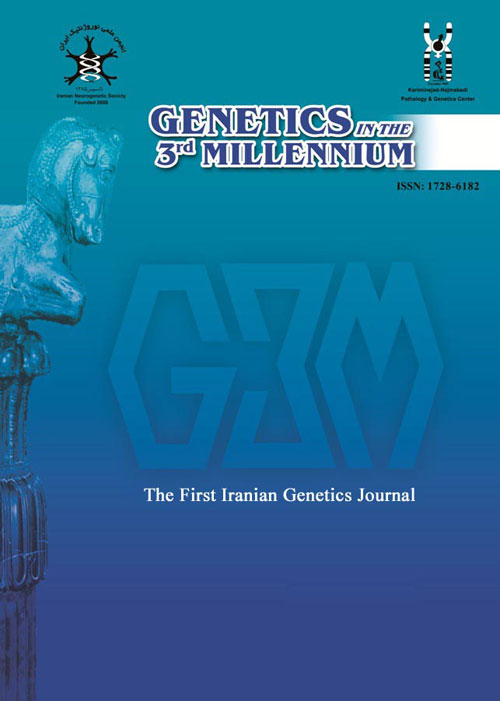فهرست مطالب

Genetics in the Third Millennium
Volume:13 Issue: 4, Winter 2016
- تاریخ انتشار: 1395/02/04
- تعداد عناوین: 8
-
-
Pages 4088-4093Normal sex differentiation is the result of long ways and different steps that consecutively take place under the control of relevant enzymes resulting in a normal female or male. Any effective agent and excess or deficit of the relevant enzymes result in the disorder of sex development. The main factors that affect sex development include chromosomal aberration, gonadal dysgenesis, and hormonal effects. Normal sex differentiation and development have been described in the first chapter in the Genetics in the Third Millennium (Vol. 13, No. 1). The disorders of sex development due to chromosomal aberration and gonadal dysgenesis have been delineated in the second (Vol. 13, No. 2) and third chapters (Vol 13, NO. 3). In the fourth chapter, we present and discuss the disorder of sex developments due to hormonal effects.Keywords: Disorders of Sex Development, Chromosomal Aberrations, Hormones, Hermaphoditism
-
Pages 4094-4099Hearing loss (HL) is the most frequent sensory defect present in 1 of every 500 newborns. In developed countries, at least 50% of cases are caused genetic factors, most often resulting in nonsyndromic HL (70%), which is usually autosomal recessive (80%). To date, fifty genes associated with autosomal recessive non-syndromic hearing loss (ARNSHL) have been reported.
The aim of this study was to determine the prevalence of mutations in four genes (GPSM2, MSRB3, SLC26A5, and GRXCR1) in Iranian deaf population with ARNSHL. These genes were mostly reported in our neighboring countries. One hundred unrelated Iranian families segregating ARNSHL with at least two affected siblings were subjected to our study.
We used homozygosity mapping to identify regions of autozygosity-by-descent using three flanking or intragenic short-tandem repeat (STR) markers for mentioned genes. If a family showed linked pattern to our selected STR markers, then direct sequencing was performed.
Seven families were linked to GPSM2, seventeen families were linked to GRXCR1, five families showed linkage to SLC26A5, and sixteen families linked to MSRB3. To confirm the mutation in linked families, direct sequencing was performed, however, after analyzing the sequencing results, no mutation could be detected in either of the families.
Our data showed that mutation in the studied genes, GPSM2, MSRB3, SLC26A5, and GRXCR1, is not prevalent in Iranian population.Keywords: Autosomal Recessive, Nonsyndromic Deafness, Homozygosity Mapping, Mutation Detection, Iran -
Pages 4100-4105Acute myeloblastic leukemia is the most frequent cancer in adults and the patients have a wide range of sub-classes. HLA DR negative cases represent one of the major immune-phenotypic classes. HLA-DR is routinely used to distinguish acute promyelocytic leukemia (APL) from other AML subclasses based on the immunophenotype. The TGF-b signaling pathway, as a critical regulator, guides different vital and sometimes opposite aspects of cell processes, including cell proliferation, apoptosis, differentiation quiescence, and malignancy expansion. A review of previous studies regarding the role of TGF-b in human malignancies made us interested in the evaluation of the role of the TGF signaling pathway in leukemia. We evaluated TGF-b /TGF-bRII fluctuant in HLA-DR negative AML, at expression level in bone marrow and peripheral blood samples. Forty-six patients were consecutively diagnosed with HLA-DR negative AML by flow cytometry, morphology, cytochemistry, and molecular analysis. By using Ficoll density centrifugation, mononuclear cells were isolated from the peripheral blood and bone marrow from both patients and controls; then, TGF-b, TGF-bRII, and ABL1 genes were amplified by quantitative Real Time PCR. The results revealed that the TGF-b expression level was not different between patients and controls while TGF-b R was higher in patients than control cases; the expression of TGF-b and TGF-bRII was significantly lower in non M3-AML (M0, M1, M2) than M3-AML (APL) (PKeywords: HLA, DR negative, Leukemia, Myeloid, Acute, Transforming Growth Factor beta, TGF, bRII
-
Pages 4106-4111The aim of the present study was to find the best or optimum topology of six chicken populations, which were genotyped based on nine highly polymorphic microsatellite markers. To reach this goal, different genetic distances based on infinite allele model (IAM), stepwise mutation model (SMM) and drawing phylogentic trees on un-weighted pair-group method using arithmetic averages (UPGMA) method were compared. For conducting this research, 16 DNA samples from each Naked Neck (NN), White Silkies (WS), Commercial Layer (CL), Commercial Broiler (CB), Giriraja (GR) and Desi (DS) populations were genotyped for this study. Some of the IAM and SMM based genetic distances showed the same topology under UPGMA. Estimates of different genetic distances revealed relatively close genetic similarity between NN and GR. In the UPGMA-based phylogenetic trees constructed from different genetic distances, four major clusters obtained first, NN and GR; second, NN, GR and CB; third, DS and CL; and forth, WS in a single cluster. The percentage occurrence of each group among genetic distances was 100, 100, 66.7 and 55.6, respectively. The correlation coefficients obtained by Mantels test ranged from 0.470 to 0.997 between different genetic distances. In conclusion, by applying this procedure, it is possible to get proper topology using different genetic distances.Keywords: Phylogenetic Tree, UPGMA, Chicken, Microsatellite Repeats
-
Pages 4112-4119Enterotoxigenic Escherichia coli (ETEC) strains are the major cause of diarrhea in new born calves and certain species such as humans, pigs and sheep. ETEC has the ability to bind with entrocytes through K99 and F41, and to produce enterotoxins as a result. The purpose of this study was to produce the recombinant FanC protein of Enterotoxigenic Escherichia coli in prokaryotic system by using pET32a() expression vector. Therefore, using specific primers and polymerase chain reaction, FanC(K99) gene was amplified from Enterotoxigenic Escherichia coli. After purification, the gene was cloned and sub-cloned into pTZ57R/T and pET32a() respectively. The recombinant vector was transferred into E.oli BL21CodonPlus (DE3) as expression host, and the produced protein was purified by Ni-NTA chromatography column. The results of protein expression showed that E.coli was able to express FanC protein appropriately. This gene was expressed by the induction of IPTG at the concentration of 1mM. This was confirmed by NiNTA column, dot-blotting analysis and SDS-PAGE electrophoresis. The concentration of the recombinant protein was calculated as 1.3 mg/ml.
The results of this study showed that E.coli can be used as an appropriate host to produce the recombinant FanC protein. This recombinant protein may be suitable to produce immunoglobulin, recombinant vaccine and diagnostic kit in future studies.Keywords: Enterotoxigenic Escherichia Coli, Cloning Molecular, Gene Expression, Recombinant Protein -
Pages 4120-4127PML (Promyelotic Leukemia) protein is a tumor suppressor protein encoded by the PML gene. This protein is known as one of the main components of PML nuclear bodies (PML-NBs) in the nucleolus. The number and morphology of these structures vary in different cells. Due to alternative splicing, post-translational modifications, and interactions with different partners, this protein has acquired different localizations and functions in the cell. Most studies have focused on the role of this protein in tumor suppression and myeloid differentiation. In this article, we review the role of this protein in cellular activity, and its importance in stem cell characteristics and neural development.Keywords: Promyelotic Leukemia, PML Nuclear Bodies, Gene, Tumor Suppressor, Cell Differentiation, Pluripotency
-
Pages 4128-4133MiRNAs are a new class of small RNAs which regulate gene expression. They are supposed to be involved in a variety of cellular functions. Although, the primary targets for miRNAs are located at the 3′UTR of the genes, there are compelling evidences that miRNAs may also bind to the regions in the coding sequence of target genes. Mostly, deregulations in the miRNAs expression lead to the progress of enormous cancers. Hence, they could serve as valid biomarkers for diagnosis of cancer stages. MiR-155 has been recently interested by a variety of laboratories. MiR-155 is proposed to function as an oncomiR. Numerous studies have reported significantly up-regulation of this miRNA in a variety of cancers. This review describes the gene structure and molecular role of miR-155 in several cancers. Therefore targeting of this miRNA is considered as one of therapeutic solution for preventing the cancer progress.Keywords: Cancer, Gene Expressions, microRNA, miR, 155, Genes, Reporter
-
Pages 4134-4137Acrocallosal syndrome is a rare autosomal recessive disorder characterized by hypoplasia /agenesis of corpus callosum, moderate to severe mental retardation, characteristic crainioafacial abnormalities and distinctive digital malformation .
Here we report a six-year-old boy with mental retardation , dolicocephally, hypertelorism, strabismus, postaxial polydactyly and agenesis of corpus callosum .
With these finding acrocallosal syndrome was suspected and KIF7 gene sequencing was performed,revealing a homozygous deletion inexon 14 of KIF7 gene. Both parents were heterozygous carriers.Keywords: Acrocallosal Syndrome, Agenesis of Corpus Callosum, Mental Retardation, KIF7


